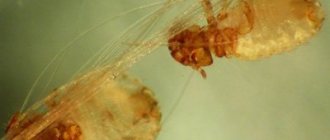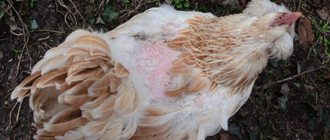Ear mites in dogs are an external parasite that lives in the outer ear of an animal. If left untreated, infection with ear mites leads to the disease otodectosis with serious consequences. The ectoparasite is widespread in the dog population. The difficulty of dealing with it is that the disease can be transmitted between animals of other species (cats, foxes, ferrets). Dog owners should know what a tick looks like, symptoms and methods of diagnosing otodecosis, control and prevention measures in order to provide timely assistance to their pet. In our material we have collected all the necessary information about this pathology.
What is an ear mite
Ear mites are microscopic ectoparasites that live in the inner ear of dogs. The scientific name of this mite is Otodectes cynotis. The eight-legged parasite, similar to a spider, is very small, its dimensions do not reach 1 mm. The environment in a dog's ear is ideal for the growth, development and reproduction of mites.
Once in the ear, the parasite chews the skin - it feeds on lymphatic (ichor) and tissue fluids. Female mites are very fertile, capable of laying 5 to 10 eggs per day. After a few days, the eggs hatch into larvae, which reach adulthood and sexual maturity after three weeks. If treatment is not started, this process can continue indefinitely .
Risk group
The infestation of the dog population with ear mites is very high. However, not all infected dogs suffer from otodectosis. In order for a colony of parasites to multiply so much that the dog gets sick, certain conditions must exist.
At risk for otodectosis:
- Young dogs (up to 6 months).
- Long-eared breeds and dogs with furry ears: spaniels, Yorkies, dachshunds.
- Hunting dogs. They can become infected from wild animals.
- Puppies that have not been treated with antiparasitic drugs.
- Dogs with weakened immune systems, sick animals, pets in recovery, exhausted dogs.
- Animals living together in shelters and dog hotels.
- Homeless, stray dogs.
Important!
The main source of ear scabies infection is stray dogs. Try to protect your pet from contact with them.
Routes of infection
No dog is protected from infection with ear mites, so all owners
We must know where these parasites come from.
A dog can become infected with otodectosis:
- upon contact with a sick animal (dog, cat, ferret, fox);
- puppies with undeveloped immunity - from a mother infected with a tick;
- through a person who had contact with a carrier animal;
- through general grooming items and dog accessories (combs, collars, leashes, bedding, toys);
- through external parasites - fleas can be carriers of tick larvae;
- through a person's street shoes and clothing.
Important!
Take precautions: do not use other people's accessories, do not allow the dog to come into contact with dirty outdoor shoes and clothes.
Can you see ear mites?
Without special equipment it is very difficult to recognize this parasite - it has microscopic dimensions. But, if your dog constantly scratches his ear and you see black dirt in his ear, you can try this before visiting the clinic.
What you will need:
- a sheet of black (dark paper);
- cotton buds;
- magnifying glass (loupe);
- bright light source (flashlight, table lamp).
Algorithm of actions:
- take a cotton swab and carefully collect the contents of the ear;
- make a dab with a cotton swab on a sheet of black paper;
- point a bright light source at the area of the stroke;
- try looking at the smear through a magnifying glass.
If you see microscopic white moving dots, your dog is infected with ear mites.
Important!
Even if you were able to see the parasites, the diagnosis must be made by a veterinarian after examining the dog and clinical tests.
Consequences of infection - what is the danger
Don't underestimate the dangers of ear mite infestation. The parasite is very small, but the consequences of otodectosis can be serious and dangerous to the health and life of the pet.
- Otitis.
- Decreased and complete loss of hearing.
- Attachment of a secondary infection, suppuration of the ear.
- Inflammatory process in the eardrum, violation of its integrity.
- Meningitis.
- In rare cases, death.
Important!
Only timely diagnosis and the correct treatment regimen can protect your pet from these serious consequences of otodectosis.
Complications
If you do not take the necessary actions in a timely manner and do not consult a specialist, your dog may develop serious complications, for example:
- Inflammation of the middle ear.
- Perforation of the eardrum.
- Meningitis.
- Labyrinthitis.
- Arachnoiditis.
It is important to remember that the complication is an inflammatory process that regresses into the inner and middle ear. From there comes the damage to the meninges. This course of events leads either to complete loss of hearing or to the death of the animal.
Symptoms of ear mange in dogs
You should know how otodectosis manifests itself. As soon as you notice at least one of these signs in your pet, immediately take your dog to the veterinarian. Ear mites reproduce very quickly, so it is important to begin treatment immediately.
Signs indicating ear scabies:
- severe itching;
- the dog shakes its head as if it wants to shake something out of its ear;
- the animal often tilts its head to the side;
- scratched head and ears;
- dark solid discharge from the ears (grains similar to ground coffee);
- unpleasant odor from the ear;
- baldness around the ears, scabs;
- depressed state of the dog, refusal to eat.
All these symptoms can be the result of other diseases (allergies, dermatitis), so do not self-medicate. Give the veterinary specialist the opportunity to examine the dog and take biological material from it for research.
Important!
Do not try to clean your dog's ear yourself before visiting the clinic - there should be some discharge left in the ear to be examined for ticks.
Briefly about the main thing
- Dog ear hygiene plays a big role in maintaining healthy ears.
- Ear diseases can be caused by many reasons, and further treatment depends on this. These are mainly: parasites, inflammatory processes, pathogenic fungi, bacteria and allergic reactions.
- The main symptoms of ear diseases: the dog scratches its ears, shakes its head, tilts its head to one side, redness and swelling of the ears, dirt and a characteristic smell from the auricle.
- Types of ear drops: for hygienic cleaning, antibacterial, antifungal and against mites.
- Many of them combine several actions.
The article is based on the expert opinion of the author. Before using medications, be sure to consult a specialist.
Diagnostics
Treatment of otodectosis begins only after confirmation of the diagnosis in a veterinary clinic. Ear mites can only be identified after laboratory testing of the ear contents (discharge).
The doctor scrapes the ear and applies the collected contaminants to a laboratory glass and presses it on top with a cover glass. All this is placed under a microscope for examination. If there were parasites in the scraping, they will be visible under a microscope.
The second diagnostic method involves examining the animal’s ears using a magnifying otoscope. An otoscope helps to see parasites, their eggs and larvae.
Additionally, bacterial culture and cytological examination of earwax may be prescribed. In this way, concomitant diseases (bacterial and fungal infections) can be identified.
Folk remedies
As practice shows, traditional medicine is not effective enough. Therefore, treatment based only on folk remedies will worsen the situation. It is not worth using such drugs without a parallel therapeutic course.
But as an auxiliary and preventive purpose, drugs have the opportunity to exist:
- One of the most common remedies is the use of camphor oil, baby oil or cream to remove dried crusts. It is convenient to apply using cotton pads.
- To disinfect the ears, you can use hydrogen peroxide. To carry out the procedure, you need to moisten a cotton swab in a 3% peroxide solution and carefully treat the surface.
- A well-known antiseptic, green tea will also help remove bacteria from the surface of the hearing aid, as well as prevent the development of tick-borne infections.
Treatment of ear mites in dogs
We would like to warn lovers of traditional and non-traditional methods of treatment - do not even try, this parasitic disease cannot be treated in such ways . Don't experiment and don't waste time. Otodectosis can only be treated with traditional medicine!
Owners of sick pets should be prepared for long-term therapy. Ear scabies can take one to several months to cure. The treatment regimen and medications are prescribed by the veterinarian depending on the severity of the disease. He also decides whether the dog requires inpatient treatment or whether therapy can be carried out at home.
Treatment in the clinic
Inpatient treatment may be necessary if the vestibular apparatus of the ear is affected. The doctor will leave the animal in the clinic for further observation and therapy. If necessary, a decision will be made on surgical intervention. All other cases do not require treatment in the clinic; the animal is sent home after examination and appointments.
How to cure at home
The first thing to do if your pet is diagnosed with otodectosis and prescribed treatment is to thoroughly clean the auricle and ear canal. This is an important part of treatment that cannot be avoided. Thoroughly cleaned ears increase the effectiveness of medications.
How to properly clean a dog's ears
First, try cleaning the ears without restraining the animal. If you don't succeed, ask someone in your household to help you. Small dogs and puppies can be wrapped in a towel or blanket. If your dog is aggressive, muzzle it to prevent it from biting you.
- drop a few drops of saline solution into each ear and massage the base of the auricle for 2-5 minutes;
- after this, straighten the dog’s ear and begin to clean the ear gently with a cotton pad soaked in saline solution or ear cleaning lotion;
- change discs as often as possible;
- treat all anatomical grooves to thoroughly clean the ear.
Lotions for hygienic ear cleaning:
- Bars (Russia);
- BEAPHAR Ear Cleaner (Netherlands);
- VEDA (Russia);
- Otifry (Poland);
- Beekeeper “Ushastik” (Russia);
- PROSENSE Ear Cleansing Liquid (USA);
- Epi-Otique (France);
- 8 in 1 EXCEL (USA).
Important!
Do not use hydrogen peroxide or other aggressive agents to clean the inner surface of the ear. These drugs can only be used for spot treatment of abrasions and wounds on the auricle.
What is included in the treatment regimen for otodectosis?
The process of treating ear scabies includes several mandatory steps:
- Elimination of itching and pain. For this purpose, antihistamines and antiseptics are used.
- Thoroughly clean the ear of secretions and dirt. Both hygienic ear solutions and saline solution are used.
- Acaricidal drugs. The type, brand and frequency of treatment are prescribed by a veterinarian.
- Preventive treatment against external parasites (ticks, fleas, lice eaters).
- Antibacterial and antifungal therapy is prescribed in case of secondary infection.
When prescribing a treatment regimen, the doctor takes into account the condition of the dog, its age, the degree of invasion and the presence of secondary infections. Each of the stages is important in the treatment regimen for otodectosis.
How to apply medicine or drops
- For dogs of long-haired breeds, the hair from the inner surface of the ears is cut off during therapy in order to increase the effectiveness of treatment procedures.
- The auricle is turned out - carefully straightened towards the back of the head.
- The spout of a bottle with drops or a tube of ointment is inserted into the ear canal so that the medicine can be dosed.
- After applying the medicine, the ear is returned to its original position and gently massaged for 1 minute.
- If manipulations cause discomfort to the animal, you need to calm it down and distract it with a treat or toy.
Important!
The pathology is highly contagious, so all animals that come into contact with a sick dog must undergo antiparasitic treatment. In addition, the pet’s habitat is disinfected.
Preparations for the treatment of otodectosis in dogs
Stronghold
The best remedy for otodectosis. A highly effective drug produced by Zoetis (Pfizer) (USA). Destroys ear mites and serves as a means of preventing re-infection. The product is characterized by low toxicity. The drug has a complex effect, fights external and internal parasites.
How to use:
The pipette with the medicine is cut and the entire contents are squeezed out onto the skin along the spine. Requires one-time use. The medicine enters the dog's bloodstream and destroys ticks. If necessary, the doctor may prescribe re-treatment a month after the first application.
Contraindications:
- puppies up to 1.5 months;
- pregnancy and lactation;
- weakened immunity, recovery period after illness;
- violation of the integrity of the eardrum;
- individual intolerance.
Price: 3 pipettes – 1170-2600 rub./180-900 UAH.
Otoferonol Gold
The targeted drug is effective only against ear mites. Ear drops relieve itching and have a healing effect. The medicine is practically not absorbed into the skin of the animal and acts locally.
How to use:
Before instilling the medicine, the dog's ears are cleaned of scabs and dirt. After this, the drops are instilled into each ear. Dosage: small dogs - 3 drops, medium - 4 drops, large dogs - 5 drops. the treatment is repeated after 5-7 days.
Contraindications:
- individual allergic reaction;
- violation of the integrity of the eardrum;
- puppies up to 2 months;
- pregnancy;
- lactation period;
- weakened and sick animals.
Price: bottle (10 ml.) – 90 rub./40 UAH.
Frontline Spot On
French-made drops with high effectiveness against ear mites. Available in drops, the packaging is an individual disposable pipette. Effective against larvae and adults. It has a complex effect, destroys fleas, lice, lice and ixodid ticks.
How to use:
Place 4-6 drops into clean ears. After this, the ears are massaged at the base. Processing is carried out once.
Contraindications:
- puppies up to 2 months;
- individual intolerance.
Price: 1 pipette – 550 rub./260 UAH.
Oricin
Insectoacaricidal drug for the treatment of otitis and otodectosis. Relieves itching and inflammation, destroys ear mites, and serves as an effective preventative.
How to use:
The prescribed number of drops is instilled into both ears - from 2 to 5. Treatment is carried out twice a day for 3-7 days.
Contraindications:
- violation of the integrity of the eardrum;
- individual allergic reaction.
Price: bottle (25 ml.) – 550 rub.
Oridermyl
Ointment for ear scabies. A broad-spectrum drug is prescribed to dogs with otodectosis, which is complicated by a bacterial or fungal infection.
How to use:
The ears are hygienically cleaned and 0.5 cm of ointment is injected into the ear canal. After this, massage the base of the ear for 1 minute.
Contraindications:
- the weight of the animal is less than 1.5 kg;
- violation of the integrity of the eardrum;
- individual intolerance.
Price: tube (10 g.) – 800 rub./200 UAH.
Important!
During the treatment process, there is a possibility that some of the parasites will leave the ear. Examine your pet and observe its behavior. If necessary, the veterinarian may prescribe additional treatment of the dog with antiparasitic drugs (Bars, Prazicide).
Video:
https://www.youtube.com/watch?v=9JRhOSkuL4E
Solutions in injections and emulsions
| 1. Neostomazan | 10-20 rub. |
| 2. Aversect | 70 rub. |
| 3. Otodectin | 65 rub. |
| 4. Epacid-Alpha | 60 rub. |
Injection solutions are the cheapest remedies for parasites. But they also have other advantages: the drugs work against all ectoparasites, and some of them are used both for treating pets and for treating premises.
Not all animal owners know about injection solutions. But this is an excellent solution - with one remedy you treat your pet and get rid of parasites in the house.
Neostomazan
Neostomazan
The cheapest remedy for ear mites for dogs is Neostomazan. They sell it for 10-20 rubles. per 1 ml ampoule. Take 2 cones of 1 ml for treating an animal, and 2 of 5-10 ml for treating an apartment/house.
Dosage for treating animals is 1 ml of medication per 200 ml of water. Neostomazan is used in 2 ways:
- wipe the ears with swabs soaked in the solution;
- bathe the dog - soak the sponge in the solution, apply it all over the body except the face, wrap the dog in 2-3 towels and keep it for 20-30 minutes.
The solution for treatment is also prepared - 1 ml per 200 ml of water. Pour the product into a spray bottle and spray thresholds, baseboards, carpets, upholstered furniture, and beds.
Neostomazan has a pungent odor like gasoline or kerosene. But it disappears in 10-15 minutes.
Aversect K&S 0.2%
Aversect K&S
Aversect is intended for intramuscular or subcutaneous injections. After administration, the medicine spreads throughout the dog’s tissues and organs and has a detrimental effect on ticks, insects, and worms.
Aversect is administered at the rate of 0.2 mg of the active substance aversectin C1 per 1 kg. After 7-10 days a second injection is given. The medicine is prohibited:
- kittens up to 7 weeks;
- whelping bitches;
- old dogs;
- sick pets.
Price – 70 rub. per ampoule.
Otodectin
Otodectin
Another solution for subcutaneous injection. Otodectin is administered to puppies from 2 months and healthy adult dogs. Use with caution in pets with liver and kidney pathologies, collie, boxer, sheltie, bobtail and related breeds. Dose – 0.2 ml of the active ingredient ivermectin per 1 kg.
A 5 ml bottle costs 65 rubles.
Epacid-Alpha
Epacid-Alpha is an emulsion based on alphacypermethrin, which acts against insects and ticks. Designed for outdoor use. Costs 60 rubles for a 10 ml bottle.
Epacid-Alfa is applied to clean skin. Shake off the bottle, draw the contents into a syringe without a needle and inject 1-1.5 ml into each ear. After 3-5 days the manipulation is repeated.
Prohibited for pregnant and lactating dogs, puppies under 2 months, and malnourished pets.
Prevention
Otodectosis is a highly contagious disease that requires a long course of treatment. To protect your pet from this infection, you need to follow the following prevention methods:
- Inspect and clean your pet's ears weekly using hygiene products.
- Carry out anti-parasitic treatment of the dog quarterly.
- Observe hygiene measures. Keep the animal's habitat clean.
- Never use other people's accessories and grooming items (leashes, collars, toys, combs).
- Clean the premises with insecticides monthly.
- Avoid direct contact between your dog and stray dogs.
How to protect your pet from such a problem?
It is easier to take preventative measures than to try to remove ear mites from your pet. Helpful Tips:
- Parasites can easily be contracted from a sick animal. When walking, it is better not to allow your dog to interact with stray animals, even if they look healthy. This is the most effective method to help prevent disease.
- Inspect your pet periodically to identify ticks in time. You need to pay attention to your ears; if there is a lot of wax in them, this indicates otodectosis. Then you need to treat them with cotton swabs.
- Use insecticides. They will be useful after successful treatment to prevent relapse. You can use drops, sprays, shampoo, lotions. You need to carefully choose the drug, taking into account the characteristics of the animal and contraindications.
To prevent a relapse, you should thoroughly clean your house. It is worth boiling all your pet’s fabric things (clothes, toys, bedding). General cleaning and disinfection should be done twice a week.
During therapy, the pet should not touch the bedding. You should also ventilate the room more often. In winter, it is worth freezing furniture and carpets. For a successful and quick recovery, it is necessary to begin treatment immediately and contact a veterinarian at the first sign.
FAQ
Can a dog spread ear mites to other pets?
Yes. At risk are dogs, cats, ferrets, and raccoons. All animals in contact must undergo treatment.
Can a person get ear mites from a dog?
Yes, ticks can move onto the human body, but they only parasitize animals; they quickly die on humans. The risk of infection is minimal; there is no need to be afraid of contact with your pet due to the fact that the tick is transmitted to humans.
However, some people prone to allergic reactions may develop a condition called “false scabies.” The symptoms of this allergic reaction are similar to those of otodectosis. This condition does not require treatment - as soon as the dog is cured, the person will lose all symptoms.
How can a pet become infected with this parasite?
In dogs, the disease is constantly diagnosed, but it does not reach epidemic proportions. It is mainly distributed on farms, fur farms and places where stray animals gather.
The pathology affects dogs regardless of age. Otodectosis is difficult in puppies 1.5-5 months old. In this case, the mother transmits the disease.
Representatives of breeds with long ears are considered the most sensitive. This is especially true for hunting dogs. The parasite passes to them from predatory animals. French bulldogs, Yorkies, Spitz dogs, dachshunds, chihuahuas, and German shepherds also often suffer from otodectosis.
Infection occurs in the following ways:
- Interaction with sick animals. Even sniffing while walking is enough. The disease is transmitted from cat to dog, that is, not only relatives can infect it.
- Through personal belongings. Parasites and eggs remain on brushes, plates, bedding, toys, which is the cause of the disease. Therefore, if several pets live in an apartment, then you need to carefully monitor hygiene.
- Through the skin and belongings of people who interacted with infected dogs and cats.
- Through fleas and flies. These insects are mechanical carriers of pest eggs.
Ear mites are not very dangerous to humans, but several cases of infection have been recorded.
The insect can remain in the ears for several months, leading to severe inflammation of the middle ear. The pest is located not only in the ears, but also on other parts of the body where the skin is thin (groin, armpits, neck). The reasons for his transition are still clearly unknown. It is necessary to remember that the parasite is transmitted to humans and, as a preventive measure, limit interaction with stray and infected animals and maintain hygiene.
Owner stories
Svetlana : “We adopted a dog from a shelter. She constantly scratched one ear. When she was examined by a veterinarian, it was discovered that she had ear scabies. The doctor prescribed Otoferonol Gold drops and said they were effective. Both ears were treated three times. There was a one-week interval between treatments. The dog was cured and the ticks were removed. For prevention, we treated the dog with Prazicide, it helps remove all external parasites.”
Nikita : “I still don’t understand where my dog picked up this infection. I admit honestly that I did not look into the ears of my pet, and did not know how to understand that the dog was sick. We went to the vet when he scratched his ear until it bled. There they took a scraping from us and found a tick under a microscope. The doctor himself cleaned my Rex’s ears, I had no idea how to do it. We were prescribed Stronghold drops for the withers. They need to be used once. A month later we went to the vet and found no ticks on the dog.”
Video:
Read also
Subcutaneous mites in dogs: treating demodicosis
What disease can lead to serious consequences for a dog’s body or even death? The most common and dangerous disease is demodicosis.
Ticks in dogs: prevention and treatment
Spring, veterinarians warn, is the beginning of the season for the incidence of piroplasmosis, a deadly disease for dogs.
Dog castration: 5 reasons for and against
Castration is one of the most responsible ways to care for a dog. With the help of the procedure you will reduce aggression and anxiety associated with testosterone
What diseases are most common in dogs? Symptoms and signs
A dog cannot complain; it is necessary to determine that it is sick by the appearance and behavior of the pet
Fleas on a dog. How to withdraw?
Fleas can cause a lot of discomfort and suffering to your animals, but they must be removed very carefully











